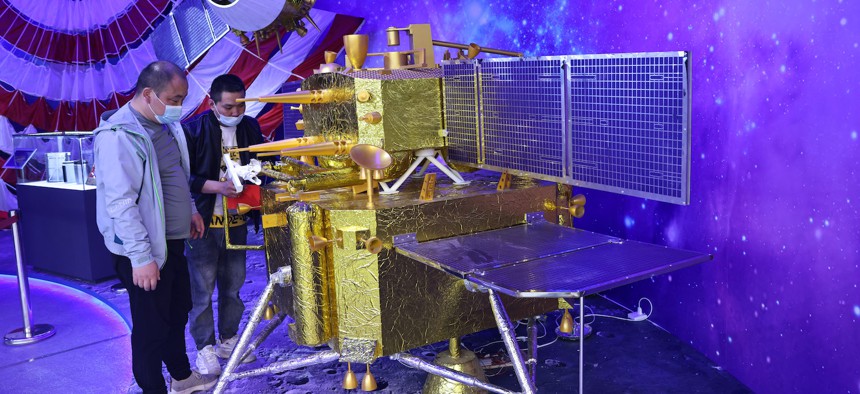
In this 2021 photo, workers arrange a model China's Chang'e 5 probe during an aerospace exhibition at Nanjing Shangqinhuai Internaitonal Culture Exchange Center in China. Yang Bo / China News Service via Getty Images
China’s moon plans worry Space Force
New orbits could open “potential attack vectors” on US satellites, general says.
The Space Force is concerned about China’s plans to operate on and around the Moon, which could enable new ways to attack U.S. satellites.
Like the United States, China is racing to put astronauts on the Moon by the end of the decade—leading Pentagon leaders to consider what new capabilities China might field if and when it gets there.
“From a military perspective, I am curious about, are there attack vectors that we haven't considered or that we need to consider, whether it's xGEO or cislunar or otherwise?” said Brig. Gen. Anthony Mastalir, commander of U.S. Space Forces Indo-Pacific, said on Monday.
But despite the race to get to the Moon, the Space Force remains focused on “deterring a terrestrial bad actor” and conflicts on Earth, Mastalir said.
“These are terrestrial conflicts that we hope we can deter and we also don't want them, although it's more and more likely, [to] extend into space or even start in space, but they’re terrestrial conflicts. Now someday in the future that may change, but for now I'd be more concerned just about what these new orbits, a moon presence—what that does for potential attack vectors to our traditional operating orbits,” he said during an event hosted by the Aerospace Corporation.
There’s “no doubt” that China will achieve its lunar goals, but the Space Force has to stay focused on traditional orbits, said Barbara Golf, strategic advisor to the U.S. Space Force for Space Domain Awareness.
“When we look at space domain awareness, we look at GEO, then LEO, then xGEO, so [I] very much agree with the prioritization to keep the eye on the ball as far as where our high value assets are, but don't have any doubt that they can do it,” Golf said Monday.
Mastalir leads U.S. Space Forces Indo-Pacific, a component under the combatant command of U.S. Indo-Pacific Command, which was stood up in 2022 to present space forces to the Pacific.
China is building a “very deliberate” space architecture specifically designed to keep the U.S. from intervening in the Pacific, Mastalir said.
“If you listen to Xi Jinping, he's made it very clear that unification, he says reunification, we say unification because the PRC and the CCP never, never had Taiwan, but reunification, in his words by 2027. That's his direction to the People's Liberation Army. So, we're not putting a timeline on it but China has, to a certain extent. So the sense of urgency to be ready to be able to close the blue kill chains, disrupt the red kill chains, that's part of why we're there,” he said.
Mastalir said the joint force depends on his component, USSPACEFOR-INDOPAC, to close long-range kill chains and counter China’s command, control, computing, communications, cyber, intelligence, surveillance, reconnaissance and targeting, or C5ISRT, systems.
“The ability to close kill chains over long distances is a top priority for the joint force, because if you can't close a kill chain over a long distance, you have to move high-valued assets closer and closer,” Mastalir said.




